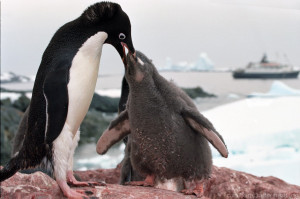Intelligence and Critical Thinking — the Foundation of Reason

Perennial symbol of intelligence, Rodin’s Thinking Man statue. Photo: Satyakamk (CC BY-SA 3.0).
One definition of intelligence has long stuck with me: The ability to recognize identities, differences, and similarities.
The first level of intelligence is that of recognizing identities. Thus, a baby penguin can recognize her own mommy or mother’s voice. Even amongst a host of other penguins squawking, the baby can home in on the one sound that is uniquely their mother’s.
This first level is, of course, the most crude and rudimentary form of intelligence. You cannot get very far with this level of aptitude. It’s too easy to be fooled by look-alikes or sound-alikes. Record the sound of momma, and the chick can be lured away from their mother. Print a large photograph of momma, and the child can be tricked into thinking it really is their mother.
Without critical thinking, humans can fall for similar tricks. It’s called “advertising,” “marketing,” or “politics.” Say something enough times on the evening news, and people will believe it. Thus, American wars become “peacekeeping” events. Don’t try to convince the victims. Peace? Sure, they’d love some, but American war tastes just as bitter as any other.
Unintelligent Americans?
Does this mean Americans are stupid? No, not at all. (And thank goodness, because I’m one.) It does mean that they are vulnerable to manipulation. Every human is. We have certain self-interests or self-concern. Those who have studied our motives can manipulate them. If we learn better critical thinking, we can boost our own intelligence. With better critical thinking skills, we become more immune to such manipulation.
Take the concept of the generality, for instance. “Everybody knows” men are smarter than women. Oops! Everybody? Who is this “everybody”?
If we think critically about “everybody,” we realize the imperfection of this claim. How can anyone survey “everybody” in order to prove such a claim? They didn’t survey me. Suddenly, the 100% perfection of the original claim is shown to have a chink—a flaw. A cursory survey of history shows many women who were incredibly intelligent—much more than me (a male). Nobel prize winning physicist Marie Curie is one such woman who comes to mind. Rear Admiral Grace Hopper, one of the world’s first computer programmers, is another one that comes to mind.
Generalities and stereotypes are an unintelligent mode of thinking that uses the first order of intelligence—identities.
These days, Americans typically think that “conspiracy theories” are “fantasy.” But are they really? Where did this “fact” come from?
If we break this down and study it, we see that “conspiracies” are quite common. In fact, in my book, Dirt Ordinary: Shining a Light on Conspiracies, I show that there are at least 489 new conspiracies starting every second, on average, somewhere in the world. That yields several billion starting every year. The way most Americans use the word “theory,” they’re referring to what scientists call “hypothesis” or “idea.” Though some ideas are based on fantasy, a great many are based on solid fact. So this identifying “conspiracy theories” with “fantasies” is, to put it politely, full of holes.

Intelligence for a penguin is simple. Antarctic Adelie penguins. Photo: Jerzy Strzelecki (CC BY 3.0).
Intelligence, Second Level—Differences
The second level of intelligence is only slightly better—recognizing differences. The penguin chick recognizes that several hundred penguin adults are not “mother.” But this is so close to the first level intelligence of recognizing identities. In one respect, it’s exactly the same. The penguin chick identifies each penguin as “not mother.” You’re “not mother,” “not mother,” “not mother.” Simple, but not terribly intelligent.
So, now the chick has two identities:
Mother
Not Mother
This level of intelligence gives us things like “outsiderness,” “xenophobia,” “prejudice,” and the like. You’re not one of us.
Intelligence, Third Level—Similarities
The third level of intelligence is considerably higher, especially when combined with the first two levels. This is the ability to recognize similarities. This is an extension of the first level, so when used alone, it lacks a great deal.
Here, the penguin chick recognizes that all of these adult penguins are similar to mother. But that one other creature is not similar. Yes, that human looks, sounds, and smells entirely differently.
But if this level of intelligence is only about “similar,” and “not similar,” then we have not progressed very far. Intelligence cannot be about digital, on-off switches.
We have to look at what is similar, what is different, and what is identical.
When we study this more closely, we see that there are different dimensions to this concept of similarity, difference, and identity. A rock may be round like a penguin, but it is not alive. A dead penguin isn’t either, but not exactly the same as a rock.
Intelligence, Fourth Level—Mix and Match?
I might add a fourth level of intelligence. I call it “mix-and-match.” It includes all three levels in various combinations. It also looks at the various objects, traits, and states as separate, but related things which we can recognize. For instance, every physical object takes up space. Conditions like “need,” “compassion,” or “love” do not take up space.
We can see that every attitude has two key vectors—toward and away from self—the holder of the attitudes.
Those attitudes that are toward self are considered self-ish. The effects those attitudes, or the actions derived from them, can have on others can be either beneficial or detrimental. So, we can have “good” selfishness or “bad” selfishness, as it applies to others.
We can also have attitudes that are toward others (away from self) which can be good or bad for those others. We can see that those actions which are bad for others usually have some selfishness attached to them for the one originating the actions. The other kind of outward attitude—the kind with good results—can sometimes have no selfishness attached to it. We call this “altruism” or “unconditional love.”
We need to question the things that “everybody” knows. For example, are all forms of socialism equal to mismanagement and tyranny?
I would like to suggest that we take a more open view of everything we think we know. Don’t confuse socialism with mismanagement and tyranny; anarchy with chaos; conspiracy with fantasy; war with peacekeeping. When someone says “climate change” equals “global warming,” question the identity. Ask probing questions to see if there are any exceptions, like global cooling. When someone says “global warming is bad,” ask why. Break the old identities and view these concepts and others from a fresh perspective.
Finding Purpose in Intelligence

Symbolic of spiritual awakening, shafts of sunlight coming through the clouds. This goes beyond mere mechanical intelligence. Rays of sunlight in St. John. Photo: Bike756 (PD).
All too frequently, intelligence is used for selfish purposes. But it doesn’t have to be this way. We can have intelligence used for altruistic or unconditionally loving intentions.
For those who reject the notion of a spiritual side to reality, I can understand and pity them. They are blind in a way which is hard to describe. Seeing through spirit is almost like a feeling which includes unconditional love. It also includes responsibility for all of those around us, not only with an active compassion, but also taking responsibility for their attitudes, beliefs, and actions. Responsibility is not blame; these two concepts are polar opposites. With perfect responsibility, we can no longer ever be victims. We become immune to self-concern. And without self-concern, we achieve freedom without limits.
Seeing through spirit includes utter humility—giving up the ego self (all of selfishness and the inward vector of attitude). This does not mean we don’t care for our own bodies, families, groups, and world. This kind of humble responsibility makes us all the more keenly aware of what is needed to nurture our condition and the conditions of those around us. It treats our enemies with the same love with which we treat our children.
And seeing through spirit includes a fearless confidence that transcends all human frailty. This kind of humble confidence is what allowed Jesus to walk on water, Moses to part the sea, and myself to perform dozens of miracles in our modern age.
The intelligence with which I was blessed I have been able to use as a tool to analyze those miracles and to understand them as a scientist understands electromagnetic fields, chemical doping of semiconductors, and the rocket thrust against gravity which was used to take men safely to the Moon and back. With this intelligence, I’ve been able to dissect and analyze the Bible, discovering the Kabbalists’ Tree of Life matrix embedded in two chapters of Genesis. I found what may be the identity of the mark placed upon Cain and the identity of the Flood’s target. I have even discovered what may be the true biblical timeline that remains compatible with those of science.
Putting Intelligence to Work
Part of the power of intelligence is in the freedom to consider all possibilities. This is why the first principle of critical thinking is to “Question Everything.” By “question everything,” I don’t mean to question it with a “rejecting” or “doubting” attitude. That’s what is so flawed about skepticism—the potent bias of “doubt.” What I’m talking about, here, is temporarily setting aside all knowledge so that none of it gets in the way of new discovery. This questioning also includes our own attitudes and skills. This questioning recognizes that we may not yet have the necessary skills to discover the answers we seek.
We need to remain humble to the Truth, whatever that truth may be. We need to hold all that we know away from us, not as if it is tainted and diseased, but as if it were once again unknown. We use this restraint and humility to let truth come to us without old ideas getting in the way. We can always reclaim that old knowledge after our investigation, if it still serves us well. Any preconceived ideas will only get in the way of intelligent discovery.
One scientist—a geoarchaeologist from Texas—once refused to believe controversial evidence, because he was too attached to the old way of thinking about North American anthropology. The laboratories which had dated the bones of Lucy, from East Africa, were used to date the artifacts found at Valsequillo, Mexico. Lucy and her date are regarded highly in science. Valsequillo and its date are either forgotten or ridiculed. The difference? Preconceived ideas and evidence. In East Africa, the evidence fit the preconceived ideas. In Mexico, the evidence contradicted the preconceived ideas. So, who was wrong? The scientists who wanted to keep their dogma alive, or the scientists who wanted to know the truth?
Every one of us has a unique intelligence. We each view the world from a different point-of-view which remains valuable to us all. If we were all to gain greater critical thinking skills to improve our intelligence and awareness, we might be able to help each other make this world into the garden it could become.
What would you like to learn?
The post Intelligence and Critical Thinking — the Foundation of Reason appeared first on Rod Martin Jr.



